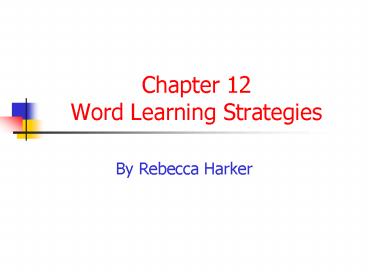Chapter 12 Word Learning Strategies PowerPoint PPT Presentation
1 / 26
Title: Chapter 12 Word Learning Strategies
1
Chapter 12 Word Learning Strategies
- By Rebecca Harker
2
Effective Word-Learning Strategies
What?
Using dictionaries Using morphemic
analysis Using contextual analysis
3
Dictionary Use
- Students need instruction in how to use what they
find in a dictionary entry. - Teacher should model how to look up meanings of
unfamiliar words and how to choose appropriate
definitions. - Students should be taught to use a dictionary to
further their knowledge of a word.
4
Morphemic (word part) Analysis
- Two basic types of morphemes
- Free can stand alone as words
- Anglo-Saxon root words
- Compound words
- Bound Cannot stand alone as words
- Prefixes
- Suffixes
- Greek roots
- Latin roots
5
Anglo-Saxon Root Words
- Cannot be broken down into smaller words or word
parts - Knowing the meaning of one root word helps the
student learn the meaning of other related words
6
Compound Words
- Contains two word parts.
- The meaning of some compound words is equal to
the meaning of the two word parts. - Example doghouse, bluebird
- Other compound words have a meaning different
than their two parts. - Example butterfly, airline
7
Prefixes
- Affixes that come before root word.
- Can alter the meaning of the word.
- Reasons to teach prefixes.
- Small number of them
- Used in a large number of words
- Usually consistently spelled
- Easy to identify
- Have clear meaning
8
Suffixes
- Affixes that follow root words.
- Can alter the meaning of the word.
- Two types
- Inflectional (-s, -es, -ed, -ing)
- Change the form of the word but not its speech
part - Derivational (-ful, -less)
- Alter root meaning
9
Greek and Latin Roots
- Cannot stand alone as words in English.
- Most appear in combination with each other
- Common Greek and Latin Roots (See pg. 494)
10
Cognate Awareness
- Words in two languages that share similar
spelling, pronunciation and meaning. - Several categories of cognates
- Cognates that are spelled identically
- Cognates that are spelled nearly the same
- Cognates that are pronounced nearly the same
- False Cognates
- Pairs of words that are spelled identically or
nearly identically but do NOT share the same
meaning.
11
Contextual Analysis
- Understanding the meaning of a word by using the
surrounding text. - Helpful context clues (see pg. 499)
- Definition
- Synonym
- Antonym
- Example
- General
- Unhelpful context clues
- Misdirective
- Nondirective
12
Word-Learning Strategies
Why?
- Students will learn words independently if they
are taught strategies for determining meaning.
13
Word-Learning Strategies
When?
- Sequence of Instruction
- Contextual Analysis
- 1st Context clues in read-alouds
- 2nd Context clues in independently read texts
- 3rd Types of context clues
- Morphemic Analysis
- 1st Compound words
- 2nd Prefixes and derivational suffixes with
Anglo-Saxon root words - 3rd Greek words
- 4th Latin roots
- 5th Greek and Latin roots plus affixes
14
Teaching Word-Learning Strategies
How?
- Using the Dictionary
- Pave Procedure
- Concept of Definition Map
- Compound Words
- Word Familes
- Word-Part Clues
- Context Clues
- Vocabulary Strategy
15
Using the Dictionary
- Direct Explanation
- Use dictionaries to define, clarify and confirm
meaning of words - Display Guidelines for Using Dictionary (see pg.
507)
- Teach/ Model
- Read all the entries
- Read all the different meaning in an entry
- Choose the meaning that makes the most sense
16
Using the Dictionary Cont.
- Guided Practice
- Practice Guidelines for Using the Dictionary
with the class.
- Independent Practice
- Allow class time for independent practice
17
PAVE Procedure
- Stands for
- Prediction, Association, Verification and
Evaluation
18
PAVE Procedure
- Direct Explanation
- Explain to student that PAVE can help them
determine meaning to unfamiliar words. - Teach/Model
- PAVE Map (see pg 512)
19
PAVE Procedure Map
- 1. Copy the Context Sentence
- 2. Print the Target Word
- 3. Predict the Words Meaning
- 4. Write a Sentence Using the Words Predicted
Meaning
- 5. Use Dictionary to Verify the Words Meaning
- 6. Revise the Sentence Using the Words Verified
Definition - 7. Draw a Picture to Associate the Words Meaning
20
PAVE Procedure Cont.
- Guided Practice
- Give student copy of PAVE map.
- Guide students through the steps
- Independent Practice
21
Concept of Definition Map
- Three Elements
- 1. What is it?
- Category the word belongs to.
- 2. What is it like?
- Characteristics of the word.
- 3. What are Some Examples?
22
Concept of Definition Map Cont.
- Direct Explanation
- Explain this map will help them understand three
elements of good definition - Teach/Model
- Complete the map (See pg. 517)
- Guided Practice
- Independent Practice
23
Compound Words
- Direct Explanation
- Meaning can sometimes be understood by the
smaller two word parts of compound word. - Teach/Model
- For ideas see pg 522
- Guided Practice
- Independent Practice
24
Word Familes
- Direct Explanation
- Remind student root word cannot be broken into
smaller words - Group of words with same root word is called Word
Family - Teach/Model
- Display examples of word families
- Explain meaning of root word
- Guided Practice
- Independent Practice
25
Word-Part Clues
- Prefixes
- Suffixes
- Roots
26
(No Transcript)

